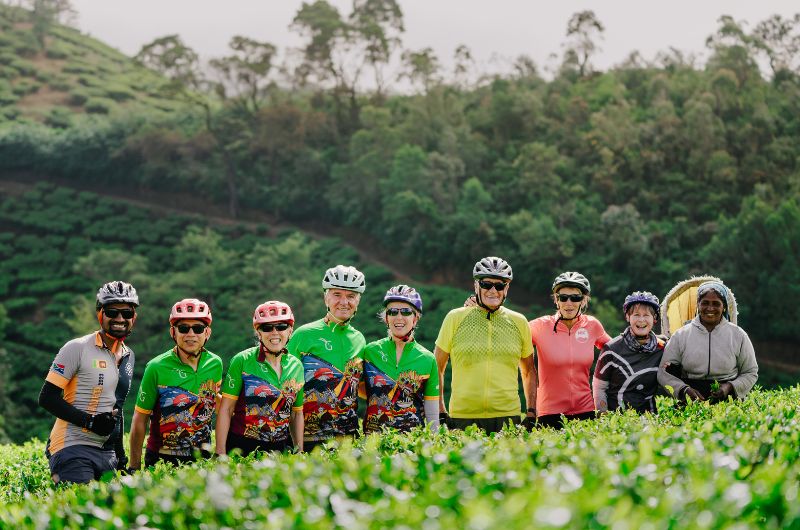Howdy partner! Or should we say 'G'day'? Actually, it could be 'Hello mate'? Or a kiss on the cheek? Oy vey, greetings can be a pickle.
Greeting styles vary wildly—and sometimes, even within the same country. And when it comes to crossing international waters, the differences become even more stark!
But forget about the customary handshakes and half-hugs because the art of saying hello is taken to a whole new level in Asia.
The cultural diversity of Asia offers a rainbow of fascinating customs, especially around greetings and hospitality. And learning them doesn't just get you past 'hello'. It allows you to transcend language barriers, respect local tradition, and sometimes saves you from embarrassment.
So, buckle up, language lovers! In this blog, we'll guide you through how to greet in 11 Asian countries.

How to greet someone in Thailand
In Thailand, people greet one another with the Wai (pronounced way). This elegant gesture entails a slight bow, with palms pressed together in a prayer-like fashion. They also embrace the Wai in various circumstances, from greetings and goodbyes to apologies and expressions of gratitude. Greetings also differ for men and women.
- For men: สวัสดีครับ (sa-was-dee krub)
- For women: สวัสดีค่ะ (sa-was-dee ka)
If a woman greets someone, the slight bow may also include bent knees.
Executing the perfect Wai involves finesse. The height of the hands and the depth of the bow depend on the age and social status of the person you're greeting. Generally, the younger individual initiates the Wai. So, when unsure, wait it out. If someone directs a Wai your way, return it with your hands positioned at your chest.
Meeting someone's grandfather, on the other hand, would necessitate a more formal wai—placing thumbs to the nose and fingertips to the forehead. The highest levels of respect reserved for monks or royalty involve lowering the head until the thumbs are between the eyebrows and the palms are positioned at chest level.
Now, with a polite hello and Wai, get ready to navigate any social situation. Discover our bike tours of Thailand.

How to greet in Vietnam
Xìn chào (zin chow)
Your go-to phrase in Vietnam, be it breakfast time or sunset, is xìn chào. Play it safe and friendly with this all-rounder hello that works for everyone. However, if you're interacting with an elderly woman, up the respect with a formal "Chao Chi," which translates as "Hello, Madame."
Don't forget, Vietnamese is a tonal language. That means when you say xìn chào, your tone can alter its meaning. Usually, from a Westerner, a friendly xìn chào meant as "hello" is well received, regardless of the tonal pitch.
For men, the greeting style in Vietnam typically involves a firm handshake coupled with an acknowledging nod. A simple yet effective way to show respect, particularly when meeting older people, is by using both hands for the handshake and giving a slight bow of the head.
Women, on the other hand, usually opt for a polite bow combined with a nod. So, when encountering Vietnamese women, respond with a friendly return nod if a bow is offered instead of a handshake.
Intrigued by the tonal Vietnamese language? in this blog post we’ll teach you the difference between tones and equip you with 23 Vietnamese phrases for your next vacation to Vietnam!

How to greet in Cambodia
The locals of Cambodia are renowned for their warm hospitality, making every visitor feel right at home. When you greet them in Khmer, their native language, it feels less like you're a traveler and more like you're reconnecting with an old friend. In Khmer there are two common ways to say "hello.".
Formal: ជំរាបសួរ (Chom Reap Sour)
This greeting is suitable when addressing older people or individuals on more formal occasions. You'll likely encounter this greeting upon arriving at your hotel or greeting locals when biking through the awe-inspiring Angkor Wat. This formal greeting shows the utmost respect and is great for travelers who wish to make a good first impression in their Cambodian encounters.
Informal: សួស្តី (Susadei)
When you're out and about tasting the different flavors of Cambodian street food or hanging out with new friends, "Susadei" is your go-to greeting. This laid-back greeting keeps the conversation friendly and light-hearted.
While saying "Hello" in Khmer, remember to complement your words with the Sampeah, a Cambodian gesture that at first glance seems similar to Thai Wai. Here are the five levels of Sampeah, depending on the person you're greeting:
- First Sampeah: For friends and peers, place both hands and palms together at chest level.
- Second Sampeah: For bosses, older people, or higher-ranking individuals, place both hands and palms together at mouth level.
- Third Sampeah: For parents, grandparents, or teachers, place both hands and palms together at nose level.
- Fourth Sampeah: For the king or monks, place both hands and palms together at eyebrow level.
- Fifth Sampeah: For praying to God or sacred statues, place both hands and palms together at forehead level.

How to greet in Laos
The most common greeting in Laos is ສະບາຍດີ (sa-bai-dee).
To greet with respect, Laotians follow a traditional act known as the “nop”, yet another prayer-like gesture that shares some similarities with Thailand and Cambodia, but also some nuances. Here's how to "nop" without being disrespectful:
- Press your hands together at chest level. This resembles the 'prayer' position known in many cultures.
- The position of the fingertips changes according to the gender and age of the person you greet.
- When women greet other women or men greet women, their fingertips should be positioned just below the chin.
- For children greeting elders, their pressed fingers should touch their nose or forehead with an accompanying bow. It's essential to note that the hands should never be raised above nose level.
- When greeting someone deserving of high respect, the head bows to meet the hands.
Eager to master the 'nop'? Try it out while ordering a fresh coconut from a local vendor after your invigorating dip in the exquisite Kuang Si Waterfalls. Take a ride through our Laos: Rivers & Villages (Bike, Hike), promising an authentic experience that goes beyond mere sightseeing.

How to greet in Bali
Bali, Bali, Bali – a traveler's paradise, echoing with vibrant culture and breathtaking landscapes—is certainly not a destination to be explored just once!
In Bali, the most common greeting is Om Swastiastu (Ohm Swah-stee-ah-stoo), which translates to "peace and greetings from God".
Traditional Balinese culture suggests placing your hands together at your chest level and, while doing so, giving a slight bow or nod, and lowering your eyes as a sign of respect.
Did you know that the Balinese greeting, "Om Swastiastu", has spiritual significance? The term originates from Hindu Balinese culture and embodies the Balinese philosophy of harmony, or 'Tri Hita Karana', which means living harmoniously with God, others, and nature.
Experience Tri Hita Karana up close while biking, hiking, and snorkeling your way from Ubud to Tulamben on our Bali: Rice Terraces & Rural Life (Bike, Hike).

How to greet in Taiwan
The primary greeting in Taiwan is 你好 (Ni Hao, pronounced Nee How), which translates to "You good." To show more respect, especially towards elders, use "Ni Hao Ma" (你好吗), which means "Are you good?" or essentially, "How are you?"
The majority of people in Taiwan came from mainland China around 1949, so they share many customs. Ensure that with every Ni Hao you make eye contact and offer a slight bow of the head to show respect. When greeting elders, direct your eyes towards the ground and always greet the oldest person first.
Often overlooked, Taiwan is an island brimming with epic adventures. Dubbed the "Hawaii of Asia," this small island is rich in cultural diversity with 16 indigenous tribes. Taiwan's bike-friendly ethos promises thrilling adventures, and our curated bike tours in Taiwan offer an unforgettable ride through the "Cycling Capital of Asia".

How to greet in Japan
In Japan, spicing up your language game starts with knowing the right greeting for the right time of the day.
Start the day with a chipper "Ohayō" (おはよう), pronounced as oh-high-yoh. Amp up the politeness, particularly when meeting someone for the first time, by saying "Ohayō gozaimasu" (おはようございます), pronounced as oh-high-yoh goh-zay-mass.
When the sun's out and chopsticks are out, use "Konnichiwa" (こんにちは). Your one-size-fits-all for "hello" or "good afternoon".
When dusk arrives? Simply switch to “Konbanwa” (こんばんは) – now, you're greeting like a local.
Japan is famous for its rich culture of etiquette, wherein greetings often come with a respectful bow. This bow can vary from a casual nod of the head to an elaborate, sweeping bow at the waist, all depending on the specifics of the situati.
Immerse yourself in the soothing ambiance of Japan's steamy hot springs and unravel the savory secret behind everyone's beloved Ramen on a delightful journey off the beaten path in Japan!
Planning a visit to Japan? Learn more handy phrases with our article on 23 useful Japanese phrases for your next vacation.

How to greet in Sri Lanka
In Sri Lanka, a friendly and respectful greeting to kick-start any conversation is to say "Ayubowan" (ආයුබෝවන්). This word, pronounced ah-you-bo-wan, literally translates to 'wishing you a long life.'
To accompany this warm wish, a physical gesture is made by bringing your hands together beneath your chin in a position akin to a prayer, followed by a gentle bow.
Here's a fascinating cultural tidbit: The phrase "Ayubowan" goes beyond its literal translation of long life, encompassing a broader wish for the other person's prosperity and happiness. When a Sri
Lankan says "Ayubowan" to you, they're wishing you more than good health – they're wishing you a life filled with joy, success, and good fortune, all expressed in a single word.
Experience the hospitality and warmth of Sri Lanka, where every greeting is a heartfelt wish for your prosperity and happiness while biking, hiking, and embarking on a safari through Sri Lanka.

How to greet in India
In India, the customary greeting to initiate any conversation is to say "Namaste" (नमस्ते), pronounced nuhm mus-teh. This Sanskrit phrase literally translates to 'I bow to you.'
To execute the 'Namaste' gesture, press your palms together in front of your chest in a prayer position, fingers pointing upwards. Accompany this with a slight bow of the head. While the act of touching another person is generally avoided in traditional settings, especially between men and women, the 'Namaste' is observed with respect across all cultures in India.
Intriguingly, the 'Namaste' greeting has a deep spiritual significance in Hindu culture, which greatly influences Indian society. It fundamentally recognizes the divine spark within everyone. When you say 'Namaste,' it acknowledges the soul in one by the soul in another.
India has one of the richest histories and heritages in the world, with many different cultures and religions followed by its people and a wide diversity of landscapes. Practice your “Namaste” as you discover the northern state of Rajasthan by bike, where grand palaces, ancient forts, and expansive desert vistas await.

How to greet in Bhutan
Dzongkha (also known as Bhutanese) is a Sino-Tibetan language spoken by over half a million people in Bhutan; it is the country's sole official and national language.
To say 'hello,' you can say "Kuzu Zangpo la" (རྫོང་ཁ།), which means "good health to you."
The traditional way to greet is with a slight bow of the head while placing your right hand over your heart. This signifies respect, humility, and a sense of gratitude toward the person being greeted, which reflects the Buddhist values ingrained in Bhutanese society.
However, in recent years, adapting to cross-cultural exchanges, handshakes have become increasingly common, primarily in urban areas or when interacting with foreigners. It's essential to remember that physical contact should be avoided or limited, particularly between genders or when meeting monks and other religious figures.
Practice your “Kuzu Zangpo la” while on a cycling adventure over the Dochula Pass, hiking up to the Tiger’s Nest Monastery, and sleeping in a historic palace on our bike tour of Bhutan.

How to greet in Uzbekistan
In Uzbek, which is the official language of Uzbekistan, there are two common ways to say "hello."
Formal: “Assalomu alaykum” (ah-sah-loh-muh ah-ly-koom) translates to 'peace be upon you'.
Informal: “Salom”
In Uzbekistan, greeting etiquette depends heavily on gender and age. As a general rule, younger people are expected to show deference to their elders. A typical greeting involves a slight bow with the right hand placed over the heart. If men are close friends or family, it's common for them to exchange brief hugs.
However, opposite genders usually avoid physical contact during the greeting. When it comes to greetings involving women, they generally keep a distance when greeting men. However, when women greet each other or children, they place their right hand on the person’s left shoulder.
Interestingly, when an elder person enters a room, custom dictates that everyone else stands up as a sign of respect.
Fascinated by Uzbek culture and history? On this Uzbekistan Bike Adventure, you won't just observe it; you will cycle through it.

Happy Hello-ing!
That was quite a linguistic journey, wasn't it!? From the elegant Wai in Thailand to the soulful Namaste in India, we've journeyed through the tapestry of traditions, exploring 10 unique ways to say hello around Asia. Nobody said it would be easy, but hey, nobody said it wouldn't be fun either!
Whether you plan a visit to a bustling city or you're ready for an exciting Grasshopper Adventures bike tour through scenic countryside, knowing these greetings will be your secret passport to authenticity. And, believe us, nothing scores more travel points than a well-executed local hello!
 By Lirene Cilliers Posted 7th Mar 2024
By Lirene Cilliers Posted 7th Mar 2024







